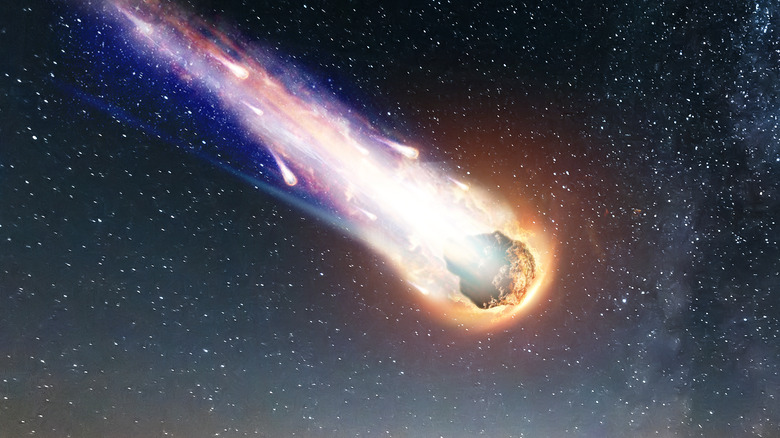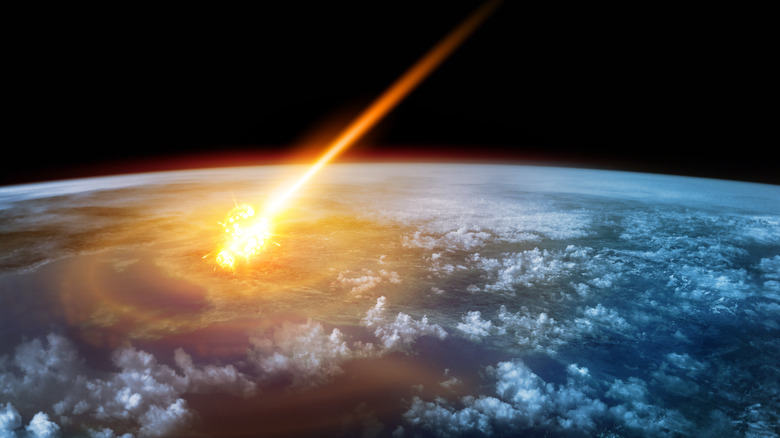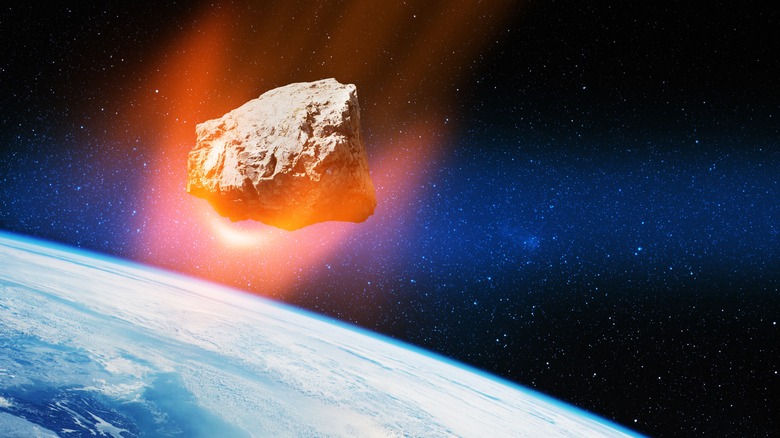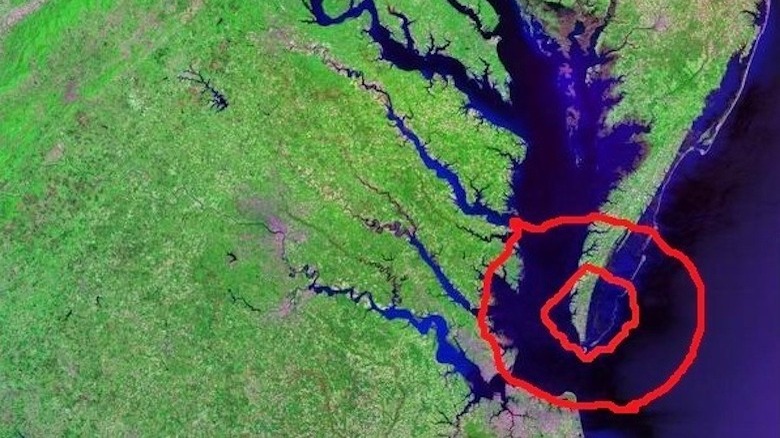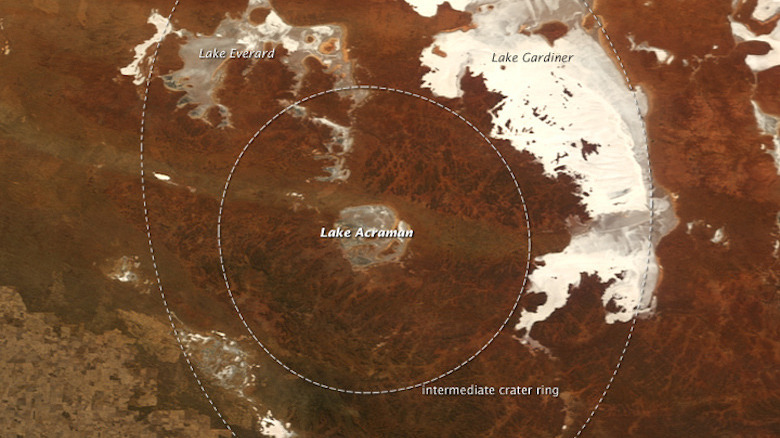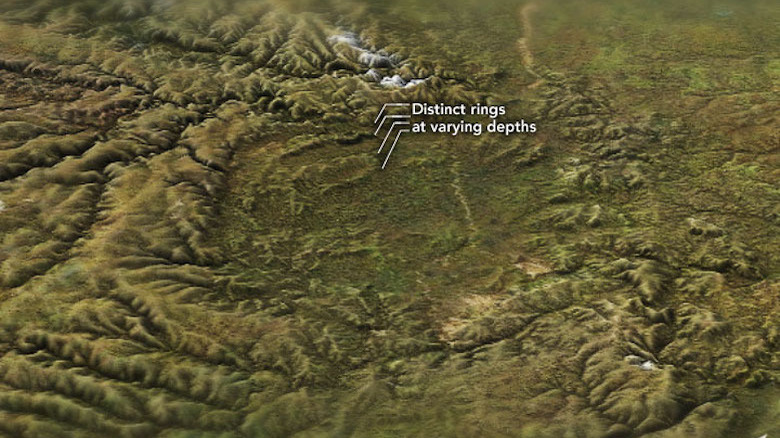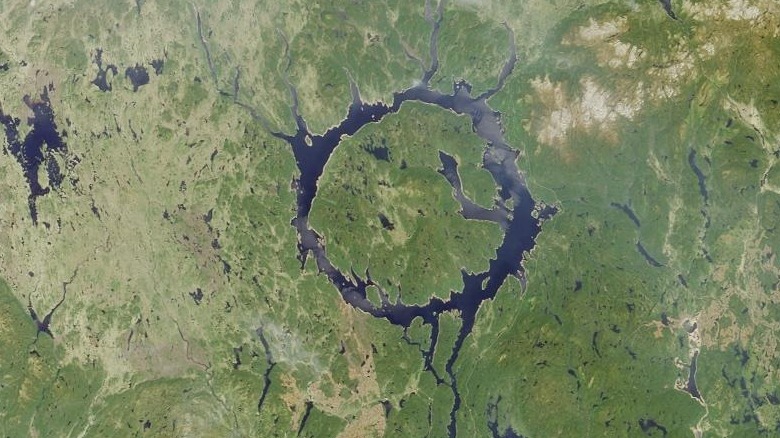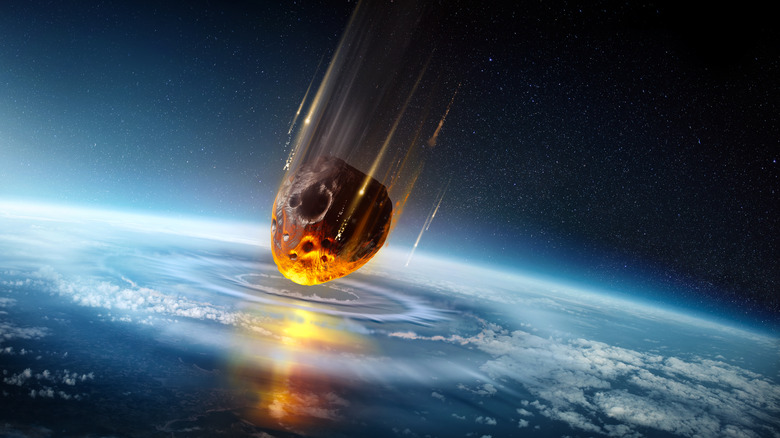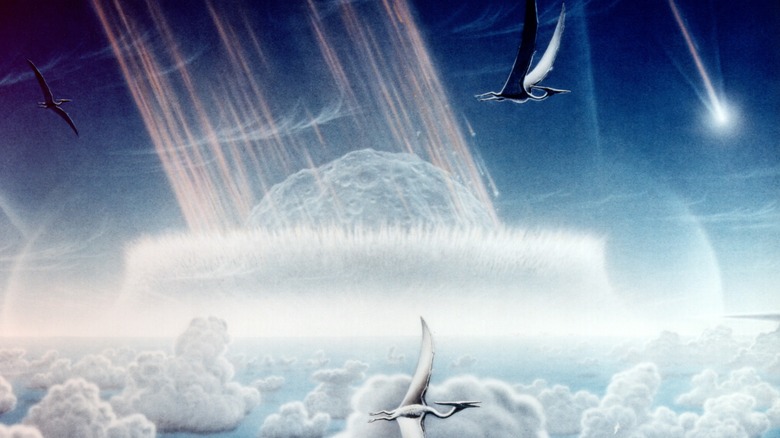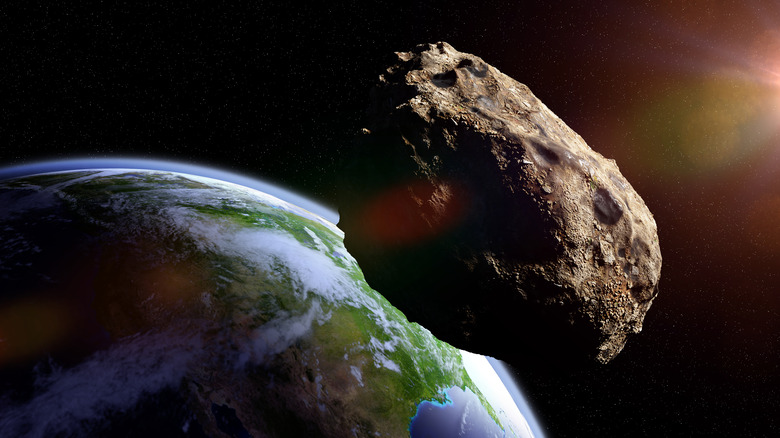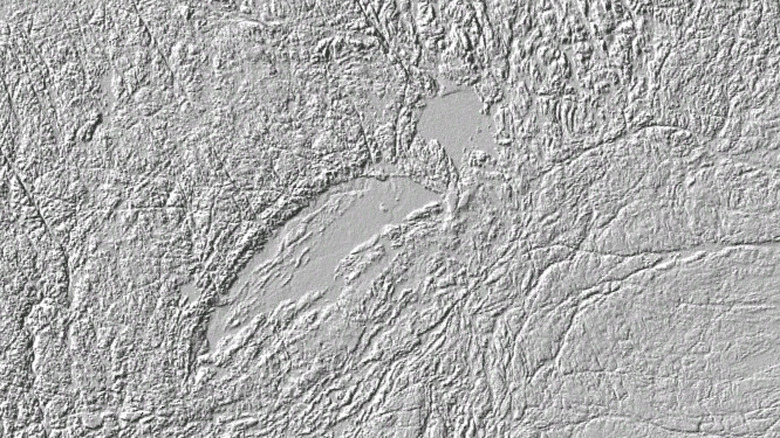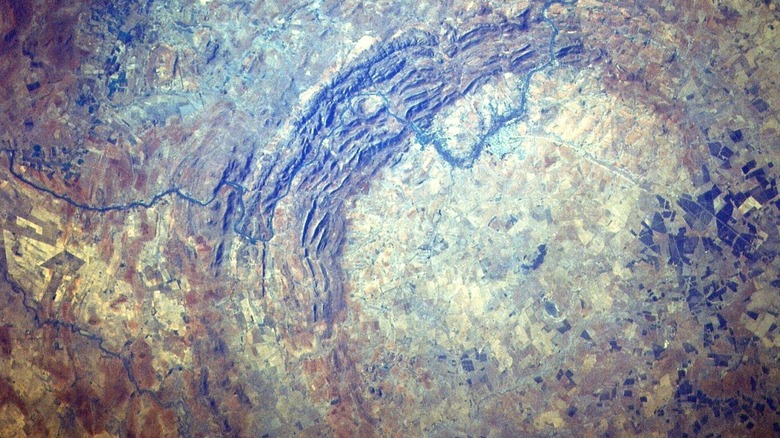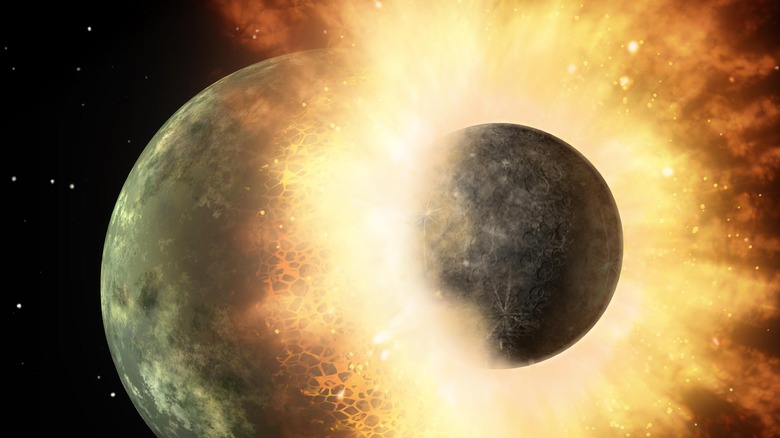The Biggest Asteroid Impacts In Earth's History
Our Solar System is absolutely teeming with asteroids, drifting hunks of rock silently tumbling through the darkness of space. And a disconcertingly large number of them pass uncomfortably close to Earth's orbit. According to a recent news release by ESA, over 30,000 of these near-Earth asteroids have now been found, and more of them are being discovered all the time. While astronomers are confident that all the largest and most dangerous asteroids are now known — and so assure everyone that Earth is perfectly safe for the foreseeable future — the smallest are no bigger than boulders, making them troublesome to spot.
In 2022, NASA's DART mission proved it's possible to protect Earth from killer asteroids by altering an asteroid's orbit, thus changing its course. The mission was a resounding success per National Geographic, working so well that the mission scientists were surprised by the result. Shortly afterward, as if to underscore the DART mission's importance, another potentially hazardous asteroid was spotted by astronomers. The Guardian notes that scientists insist that there's nothing for people to worry about at the moment, but this may not always be the case.
Plenty of asteroids have struck Earth during the last few billion years, sometimes with disastrous consequences. Virginia Places explains that over the past 650 million years, there have been hundreds of asteroids that impacted Earth with enough force to leave a crater over 12 miles in diameter. The biggest of these had global effects, and the planet still bears the scars today.
Eltanin Impact
Around 2.5 million years ago, an asteroid impact caused a maelstrom of sudden climate change. Striking the planet in the southern Pacific Ocean, Geology Hub notes that this impact is directly linked to the start of an ice age which formed much of the Arctic ice cap. Known as the Eltanin impact, the crater left by this asteroid was elusive to find ... because it's on the seafloor. When it plunged into the ocean, this impact would have caused a "megatsunami," according to Science Daily, large and powerful enough to ravage coastlines around the Pacific rim. At the same time, the impact cast huge amounts of water vapor up into the atmosphere, together with dust and sulfur. The result was a dramatic reduction in sunlight reaching Earth's surface, throwing the world into an impact winter as temperatures plummeted, as described by Britannica.
Even without knowing the location of the impact crater, there's plenty of evidence in the South Pacific for this impact event. A study published by the Journal of Quaternary Science explains that the mega-tsunami caused by the Eltanin impact left telltale signs across Chile, New Zealand, and Antarctica, leaving both chaos and deposits of ocean sediment in its wake. This was happening at the same time that Earth was going between the Pliocene and Pleistocene epochs. The latter period is known for its repeated ice ages, during which vast ice sheets covered the Earth in glaciation events — and it's quite possible this asteroid impact kicked off the climate chaos that followed.
Tookoonooka Impact
Not all meteor craters are still on the Earth's surface. Some, like the mysterious Tookoonooka crater, are now completely buried. A study published in the journal Meteoritics explains that this crater is part of a huge impact structure over 40 miles wide, and was formed by an asteroid that smashed into Earth some 128 million years ago. Ever since the impact first happened, it's been slowly buried by sediment, and all trace of the crater is now over half a mile below ground — it's possible to stand right on top of it without even realizing it's there.
The technical name for a crater caused by a meteorite impact, together with the disrupted geology around it, is an astrobleme (per Britannica), and studying one like the Tookoonooka crater is understandably not easy. Being completely buried, the only way to examine the rocks directly is to drill down to get to them. A paper from the Cooper and Eromanga Basins conference, held in Australia, explains how this kind of drilling helped to uncover the crater's origins. Discovered in an oil field, everything about the site points to it being an astrobleme, showing signs of shocked quartz, shattered rocks, and minerals that were turned to glass in the impact.
Chesapeake Bay Impact
The Chesapeake Bay, stretching from Maryland to Virginia, is a well-known location on North America's East coast, and, per NOAA, it's also home to the largest river estuary in the US. While it may be a scenic spot now, 35 million years ago it was anything but calm. According to Virginia Places, the bay is home to a crater left behind by a meteor up to 3 miles in diameter, which plunged into the Atlantic ocean, shattering the surrounding rock and sending a plume of water vapor and stony fragments up to 30 miles into the air. This material rained back down on the surrounding area, and a telltale sign is the tektites that can be found in the area — the Australian Museum explains that these are rounded, glassy stones formed when a meteorite impact blasts globules of molten rock into the air.
The Chesapeake Bay impact would have been devastating for the surrounding area. Superheating the atmosphere as it crashed down, catastrophic firestorms and violent winds would've ravaged the landscape, and the impact itself would've triggered an immense tsunami. The long-term effect though, as the USGS notes, is that the impact likely helped form the bay itself. After shattering the surrounding rocks and filling the area with fault lines, the impact disrupted nearby aquifers, but most of all, it left a lasting depression in the Earth's crust. This scar left by the Chesapeake Bay impact later defined the location of the bay as it's seen today.
Acraman Impact
Australia's Lake Acraman sits at the heart of the Acraman crater, a vast, complex formation caused by an asteroid impact that disrupted Earth's crust over an area with a diameter of over 90 miles. According to NASA Earth Observatory, the impact event which created this crater's concentric rings struck the planet around 590 million years ago. This is old enough that it predates most of the world's fossils, having happened long before the Cambrian Explosion, which filled the world with complex life more familiar to us today (via Britannica). The few fossils from this ancient chapter of Earth's history include creatures known as acritarchs, which are frequently microscopically small. Around the time of the Acraman impact, these microfossils show a sharp change, meaning that the primitive fauna of Earth changed very suddenly.
In other words, there's a good chance the Acraman impact may have caused one of the earliest known mass extinctions. A paper in the Journal of the Geological Society finds that the Acraman impact would certainly have released enough energy to cause a catastrophe of this scale. A previous contender for the cause of this change in ancient biodiversity was a major climatic event — the Marinoan glaciation, per Britannica — which saw most of Earth's surface covered in ice. However, the asteroid impact is a far better fit, having struck much closer in time to the enormous upheaval in biodiversity, so it appears the Acraman crater is a smoking gun for this ancient extinction event.
Popigai Impact
In the icy cold of Siberia lies one of the best-preserved impact craters on the planet. According to NASA Earth Observatory, the Popigai impact occurred around 36 million years ago, leaving behind a crater roughly 60 miles in diameter. Its cause was an asteroid up to 5 miles wide, which smashed into Earth at a blistering 12 miles per second. The ground where this asteroid landed, known as the Anabar Shield (as described in Developments in Precambrian Geology), is rich in graphite, and when the Popigai impact melted around 420 cubic miles of Earth's surface, vast swathes of graphite flakes were instantly transformed into diamonds. The result is that the Popigai crater is surrounded by one of the world's largest known diamond fields, forming a ring around the impact site. The heart of the crater, however, is free of diamonds: In the intense heat, any diamonds there would've been instantly vaporized.
The Popigai impact has also been implicated in a mass extinction that took place around the same time period, during the Eocene. This probably isn't a surprise when you consider that, as Live Science explains, it created one of the 10 largest impact craters on Earth. Although the Eocene extinction was previously blamed entirely on climate change, as described in Nature, studies have since found it was likely the Popigai impact that caused a sudden but dramatic drop in temperatures, killing off many of Earth's marine animals.
Manicouagan Impact
The Manicouagan crater is probably one of the world's most dramatic when seen from orbit. So dramatic, in fact, that it's been a favorite photography landmark for astronauts for nearly half a century. The plateau at the heart of the crater is the circular René-Levasseur Island, around 40 miles in diameter, surrounded by an annular lake. Found in Quebec, Canada, NASA explains that it was created by an asteroid 3 miles in diameter, which impacted around 215 million years ago during Earth's Triassic period, when the planet was still home to dinosaurs. Like with some other large impact sites, the crater has multiple concentric rings, with the largest measuring 60 miles from side to side.
While this wasn't the impact that ultimately wiped out the dinosaurs, it's been linked with a sizable extinction event nonetheless. According to NASA JPL, this extinction happened near the end of the Triassic period and saw Earth lose around 60% of all species living at the time: The Manicouagan impact is a prime contender as the cause. The Universities Space Research Association, however, notes that this impact is so far not proven to have caused any extinction, but that one this large would still have caused the kind of sudden extensive global cooling that major impact events are known for.
Woodleigh Impact
It's not unusual for species on Earth to go extinct, sad though it may seem, and this is simply a part of life. Major extinction events, however, are rare, and the American Museum of Natural History lists the Devonian Extinction as one of the worst five that Earth has ever known. Named because it occurred during the Devonian period of Earth's natural history, this is also referred to as the Hangenberg Event, and it caused a mass die-off of tropical marine species around the world. This event may also have been caused by an asteroid impact, specifically the Woodleigh impact event, according to a paper published in Palaeogeography, Palaeoclimatology, Palaeoecology.
The Woodleigh impact happened around 360 million years ago, per New Atlas, crashing into what is now Western Australia. The crater it left behind could be one of the world's largest, with estimates ranging from anywhere between 40 and 100 miles. Unfortunately, it's hard to say the exact size of this crater, because it's hidden deep underground. The best clue comes from a mineral in the surrounding rocks, called reidite. A rare type of stone, it's formed only under very specific conditions with immense pressure, just like those created during the impact of an asteroid. The reidite shows that this crater may be larger than scientists originally thought: According to a paper in Meteoritics and Planetary Science, it could have a diameter of just under 75 miles, which would make it Australia's largest crater — and one of the largest anywhere in the world.
Chicxulub Impact
The Chicxulub impact event is the most famous killer asteroid in the history of the world. As Atlas Obscura explains, this is the asteroid that struck what is now Mexico's Yucatán peninsula 65 million years ago, wiping out half of all species on the planet, including the dinosaurs. The Chicxulub impact hit Earth with such force, it caused volcanic eruptions and earthquakes across the planet, and mega-tsunamis thousands of feet high ravaged coastal areas — the crater left by the impact still spans 110 miles in diameter. However, little trace of the impact can be seen today, though signs of it are still found in the geology of Central America. Telltale clues, per the Universities Space Research Association, include unique rocks formed in the impact, like shocked quartz and melt spherules.
The immediate effects of the Chicxulub impact were nothing short of devastating. National Geographic describes how the asteroid would've released so much energy when it struck Earth that fires would have raged everywhere within a 900-mile radius, and even more fires would've started further afield as superheated ejecta from the collision rained down to Earth. The charcoal from these wildfires can still be found, trapped between layers of rock in Mexico — a permanent record of one of the most devastating moments in Earth's history.
Warburton Impacts
The Warburton craters were discovered relatively recently, in South Australia, and date back around 300 million years. At over 120 miles in diameter, Australian Geographic highlights that it's likely one of the largest impact sites ever discovered. During the moment of impact, superheated rocks melted and formed into glass, which, over a vast gulf of time later, piqued the interest of geologists. While investigating this, they realized that an asteroid was the only possible cause of the Warburton craters because the only other possible candidate would have been a volcano and, quite simply, volcanoes aren't able to produce something this large. Larger than the Chicxulub crater, the Warburton impact site is the third largest confirmed impact site to have been discovered on Earth to date.
But perhaps the most interesting thing about the Warburton craters is the fact that there are two of them. As Nature explains, the Warburton basin contains a pair of craters, both over 120 miles across, and this is unlikely to be a coincidence. One likely explanation is that these craters came from two pieces of the same asteroid, which broke in half as it fell into Earth's atmosphere. Puzzlingly though, an impact this size should have had enough of an effect that other clues about the impact would be seen elsewhere on Earth, but nothing has been found so far.
Sudbury Impact
Canada's Sudbury Basin is one of the oldest known impact sites, a sprawling crater with an elliptical shape. Per NASA Earth Observatory, it was formed by an impact 1.8 billion years ago, and the eons have eroded it so much that it's now quite difficult to see, even from orbit. The region is also full of mines, as Scientific American highlights, extracting metals like nickel, copper, and palladium from the surrounding rocks. It's by no coincidence that this impact crater is so full of metals: The Sudbury impact was powerful enough that it punched a hole through Earth's crust, allowing magma from below to then flood the crater, briefly becoming a sea of lava. Rich in metals, this lava quickly solidified into the ore-rich rock which is mined in Sudbury today.
Another interesting point about the Sudbury impact is that it may not have been an asteroid, but a comet. According to CBC, any object which falls to Earth carries a chemical signature with it, and while asteroids and comets carry similar elements, there are noticeable differences. Even though this impact is so far into the past, the chemical elements it left behind in the surrounding rocks better match a comet as the likely culprit. And unlike asteroids, comets are mostly made of ice, meaning that for a comet to not only survive falling through Earth's atmosphere but also leave such a sizeable crater on the planet's surface, it must have been very large indeed.
Vredefort Impact
Vredefort crater is widely considered the largest known impact structure in the world and is listed by UNESCO as a world heritage site. Near Johannesburg in South Africa, the impact which formed this crater happened over 2 billion years ago. The entire impact site spans over 230 miles from side to side, and NASA Earth Observatory notes that the crater itself may have been over 180 miles in diameter when it was first formed. Being so old, though, it's difficult to be certain of its original size because of how eroded it is: Today, only half the crater is even visible. The only reason this crater is even known to us is because of its sheer size — the impact was so powerful that it upended Earth's crust for miles in all directions.
A truly titanic collision, the University of Rochester explains that the asteroid which caused the Vredefort impact may have been over 15 miles in diameter and traveling at a speed of around 12 miles per second — for comparison, Mount Everest is 5.5 miles tall (via Live Science). An impact this size would have been nothing short of devastating, with disastrous consequences all across the globe. Mercifully though, Earth was a very different place 2 billion years ago, and the only living things on the planet at the time were single-celled microbes in the shallow seas.
Theia Impact
To find the biggest impact Earth ever suffered, you need to go all the way back to the earliest days of the Solar System. Shortly after Earth was newly formed, some 4.5 billion years ago, it was struck not by an asteroid, but by a small protoplanet. The Mars-sized world which collided with ours has been dubbed Theia, and this idea is known as the Giant Impact Hypothesis (via Space). The result of this immense collision can be seen from anywhere in the world, especially during a full moon — after all, this is the event that created the moon.
The remains of Theia's impact lie deep underground. As Science explains, inside Earth's mantle are two hulking layers of rock the size of continents. Distinct from the surrounding rocks, these two mysterious chunks of molten stone lie on either side of Earth's core. Evidence suggests they may be a telltale sign of the impact that formed the moon, in which dense material which was thrust down towards the planet's core when it collided with Theia.
Theia's impact blasted a massive amount of material into orbit, per NASA, which then coalesced into the moon. While older ideas were that the moon took a long time to slowly emerge from the orbiting material, some simulations have shown that it may have happened with remarkable speed, with the moon forming mere hours after Theia's impact.
